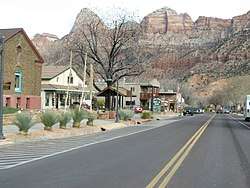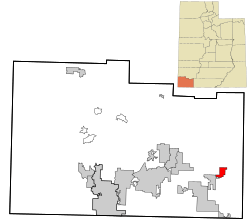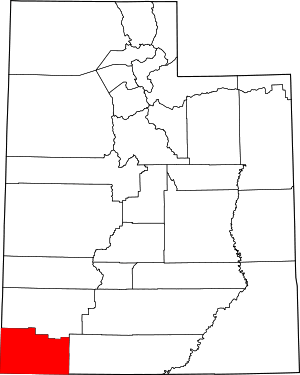Springdale, Utah
Springdale is a town in Washington County, Utah, United States. The population was 529 at the 2010 census. It is located immediately outside the boundaries of Zion National Park, and is oriented around the resulting tourist industry.[5] It was originally settled as a Mormon farming community in 1862 by evacuees from the flooding of nearby Northrop.[6] Springdale was named one of the 20 'prettiest towns' in the United States by Forbes Traveler in 2008.[7]

Springdale, Utah | |
|---|---|
 | |
 Location in Washington County and the state of Utah | |
| Coordinates: 37°11′4″N 112°59′59″W | |
| Country | United States |
| State | Utah |
| County | Washington |
| Settled | 1862 |
| Named for | Springs |
| Area | |
| • Total | 4.62 sq mi (11.96 km2) |
| • Land | 4.62 sq mi (11.96 km2) |
| • Water | 0.00 sq mi (0.00 km2) |
| Elevation | 3,898 ft (1,188 m) |
| Population (2010) | |
| • Total | 529 |
| • Estimate (2019)[2] | 629 |
| • Density | 136.24/sq mi (52.60/km2) |
| Time zone | UTC-7 (Mountain (MST)) |
| • Summer (DST) | UTC-6 (MDT) |
| ZIP codes | 84767, 84779 |
| Area code(s) | 435 |
| FIPS code | 49-71840[3] |
| GNIS feature ID | 1432867[4] |
History
The 1992 St. George earthquake destroyed three houses as well as above- and below-ground utilities, causing about US$1 million in damage.[8][9] In the Balanced Rock Hills area of Springdale, a landslide covered part of Utah State Route 9, taking several hours to complete movement.[9] The slide was about 1,600 feet (490 m) long and 3,600 feet (1,100 m) wide, contained boulders up to 20 feet (6.1 m) in diameter, with a total volume of 18,000,000 cubic yards (14,000,000 m3) and total area of 4,400,400 square feet (408,810 m2).[9][10]
Geography
According to the United States Census Bureau, the town has a total area of 4.6 square miles (12.0 km2), all land.
Demographics
| Historical population | |||
|---|---|---|---|
| Census | Pop. | %± | |
| 1880 | 50 | — | |
| 1890 | 73 | 46.0% | |
| 1900 | 144 | 97.3% | |
| 1910 | 186 | 29.2% | |
| 1920 | 204 | 9.7% | |
| 1930 | 351 | 72.1% | |
| 1940 | 454 | 29.3% | |
| 1950 | 174 | −61.7% | |
| 1960 | 248 | 42.5% | |
| 1970 | 182 | −26.6% | |
| 1980 | 258 | 41.8% | |
| 1990 | 275 | 6.6% | |
| 2000 | 457 | 66.2% | |
| 2010 | 529 | 15.8% | |
| Est. 2019 | 629 | [2] | 18.9% |
| U.S. Decennial Census[11] | |||
As of the census[3] of 2010, there were 529 people, 252 households, and 137 families residing in the town. The population density was 115 people per square mile (44.1/km2). There were 327 housing units at an average density of 71.1 per square mile (27.3/km2). The racial makeup of the town was 90.2% White, 0.9% African American, 0.6% Native American, 0.8% Asian, 5.7% from other races, and 1.9% from two or more races. Hispanic or Latino of any race were 11.2% of the population.
There were 252 households, out of which 15.1% had children under the age of 18 living with them, 44.0% were married couples living together, 6.7% had a female householder with no husband present, and 45.6% were non-families. 34.2% of all households were made up of individuals, and 8.7% had someone living alone who was 65 years of age or older. The average household size was 2.38 and the average family size was 2.67.
In the town, the population was spread out, with 15.3% under the age of 18, 4.5% from 20 to 24, 24.2% from 25 to 44, 35.4% from 45 to 64, and 18.9% who were 65 years of age or older. The median age was 47.8 years. For every 100 females, there were 106.6 males. For every 100 women age 18 and over, there were 106.5 men.
As of 2000, the median income for a household in the town was $41,607, and the median income for a family was $51,500. Males had a median income of $34,063 versus $26,667 for females. The per capita income for the town was $25,593. About 8.3% of families and 9.0% of the population were below the poverty line, including 12.0% of those under age 18 and 12.3% of those age 65 or over.
References
- "2019 U.S. Gazetteer Files". United States Census Bureau. Retrieved August 7, 2020.
- "Population and Housing Unit Estimates". United States Census Bureau. May 24, 2020. Retrieved May 27, 2020.
- "U.S. Census website". United States Census Bureau. Retrieved 2008-01-31.
- "US Board on Geographic Names". United States Geological Survey. 2007-10-25. Retrieved 2008-01-31.
- Carlisle, Nate (June 12, 2012). "Audit: Small town Utah cops targeted foreign tourists". The Salt Lake Tribune. The Salt Lake Tribune. Retrieved Jan 11, 2013.
- Webb, R. H.; Blainey, J. B.; Hyndman, D. W. (2002). "Paleoflood Hydrology of the Paria River, Southern Utah and Northern Arizona, USA". In House, P. Kyle (ed.). Ancient floods, modern hazards: principles and applications of paleoflood hydrology. 1. American Geophysical Union. p. 297.
- "Archived copy". Archived from the original on 2008-10-11. Retrieved 2008-10-13.CS1 maint: archived copy as title (link)
- Associated Press (May 15, 1994). "'92 quake left St. George virtually unshaken". Deseret News. Retrieved March 18, 2020.
- Christenson, Gary E., ed. (1995). The September 2, 1992 ML 5.8 St. George Earthquake, Washington County, Utah (PDF). Utah Geological Survey. ISBN 1-55791-367-6. Archived (PDF) from the original on December 13, 2016. Retrieved March 18, 2020.
- Associated Press (September 3, 1992). "Southwest Utah Is Jolted by Early-Morning Quake". Deseret News. Archived from the original on March 18, 2020. Retrieved March 18, 2020.
- "Census of Population and Housing". Census.gov. Retrieved June 4, 2015.
External links
| Wikimedia Commons has media related to Springdale, Utah. |
| Wikivoyage has a travel guide for Springdale (Utah). |
